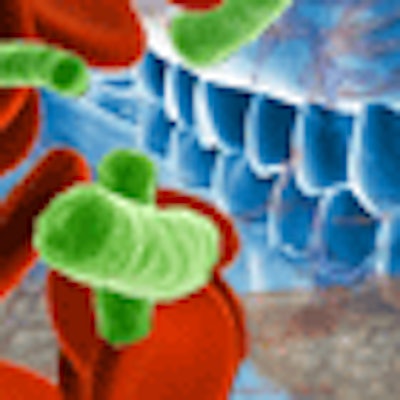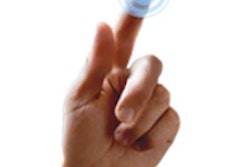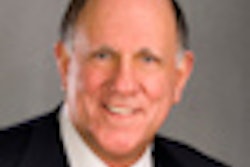
Will oral health providers one day be able to scout for evidence of systemic disease in the time it takes to clean a patient's teeth? It's an ever-likely scenario, according to those at the forefront of salivary diagnostics research.
Salivary diagnostics moves into the mainstream
Will oral health providers one day be able to scout for evidence of systemic disease in the time it takes to clean a patient's teeth? It's an ever-likely scenario, according to those at the forefront of salivary diagnostics research.
Clinical discoveries published in recent years have advanced the odds of salivary diagnostics becoming a chairside tool that could enhance the ability of dental practitioners to detect a spectrum of medical conditions.
Scientists working with saliva samples obtained from a group of Indian patients, for example, were able to validate the ability of portable electromechanical biosensor hardware technology to simultaneously analyze oral fluids for biomarkers thought to signal the pathogenesis of oral cancer (Clinical Cancer Research, July 1, 2009, Vol. 15:13, pp. 4446-4452).
A similar device developed by scientists and engineers in California sits at the cusp of commercialization (Annals of the New York Academy of Science, March 2007, Vol. 1098, pp. 401-410). The prototype Oral Fluid Nanosensor Test (OFNASET) awaits regulatory approval, with two contract manufacturing organizations waiting in the wings to begin commercialization.
And numerous studies funded by the National Institutes of Health (NIH) and others in 2009 and 2010 have pushed the salivary diagnostics envelope to its most advanced position yet, with molecular biomarkers being identified to monitor the systemic creep of breast, ovarian, pancreatic, and lung cancers.
And these advances represent just a portion of the salivary diagnostics portfolio. Combinations of analytes found in whole and ductal saliva are being characterized in ways that allow investigators to view them as molecular "proxies" for a host of systemic or systemic-related conditions, including periodontal infection, diabetes, human immunodeficiency virus (HIV), hepatitis, and cardiovascular disease.
In addition, investigators continue to refine ways to link the basic investigative tools of molecular biology -- such as mass spectrometry and microarray analysis -- with microfluidics and nanotechnology engineering, enabling them to develop portable salivary assay platforms for use in the dental operatory. If myriad challenges associated with regulatory approval, licensing, commercialization, and third-party reimbursement can be met, oral care providers may one day soon find themselves offering diagnostic health services that can identify life-threatening conditions.
Painless chairside option
The idea of an inexpensive and painless chairside option to blood or urine collection for disease diagnosis captivates the imagination of people like David Wong, DMD, DMSc, the associate dean of research at the University of California, Los Angles (UCLA) and director of the Dental Research Institute at the UCLA School of Dentistry.
"There's something very magical about salivary diagnostics," he said in an interview with DrBicuspid.com. "It has this resonance. It just echoes within the profession. Seemingly, there's this yearning for the profession to be able to move itself forward through a scientifically credible portfolio that, at least in the very beginning, they can claim is theirs."
Dr. Wong's name is attached to scores of papers on the subject. He and others have published prolifically on salivary diagnostics since 2002, when the National Institute of Dental and Craniofacial Research (NIDCR) awarded seven NIH grants to pursue development of a microelectromechanical systems approach to the nascent discipline. Funding was extended to a consortium of researchers that included Dr. Wong's group and scientists at the Scripps Research Institute, the University of Rochester, the University of Southern California, and the University of California, San Francisco.
The Wong Lab has since earned a special place in the research spotlight for its oncology studies, its collaborative work on the OFNASET portable device, and its sponsorship of the Salivaomics Knowledge Base (SKB). The latter is a collection of data "alphabets" describing the accumulated knowledge of saliva's molecular constituents, with primary emphasis on proteins and messenger RNA (mRNA) transcripts and secondary attention devoted to the metabolites, micro-RNAs, and microbes in oral fluids.
Dr. Wong acknowledged that the clinical utility of protein- and mRNA-specific alphabets in the SKB has so far eclipsed that of the other three analyte categories.
"Based on our own experience, what is important is to have the best capability to find the most discriminatory markers," he explained. "Using all five [alphabets] in any disease is ideal, but it's not practical."
The discovery of biomarkers via two-dimensional gel electrophoresis, for proteins, and reverse transcription polymerase chain reaction methodology, used to trace mRNA transcripts back to their complementary DNA, represents just two of the numerous methods being deployed to complete a portion of the salivary diagnostics puzzle. For their part, engineers are challenged to wed technologies that yield guidance at the proteome- and genome-wide level with compact nano- or micro-scaled platforms that can, at chairside, winnow the evidence down further to highly discriminatory panels of disease-specific biomarkers.
Microfluidics systems might be rendered in various combinations that merge components such as sensors or actuators with silicon substrates, allowing for the site-specific analysis of saliva samples and reagents. In the 2009 Clinical Cancer Research study of saliva from Indian patients, for example, a portable system was able to quantify interleukin biomarkers with a sensitivity and specificity nearly equal to that of traditional assay techniques. These claims are also made for the OFNASET device.
Oral cancer and Sjögren's syndrome
As new tools and assays emerge, investigators are expanding and refocusing the theoretic boundaries of oral fluid diagnostics while maintaining an investigative focus on those diseases that hold the greatest promise for application of the science in the near- to midterm.
"As I scan around, what I see that's in the pipeline is oral cancer and Sjögren's syndrome," Dr. Wong said. "That's what I'm seeing. There are other developments as well, but they're very, very early."
Oral squamous cell carcinoma (OSCC) and Sjögren's syndrome have indeed commanded a great deal of attention under NIDCR's proof-of-concept umbrella. A 2007 study in Arthritis & Rheumatism (November 2007, Vol. 56:11, pp. 3588-3600) found that 16 whole saliva proteins were down-regulated and 25 more were up-regulated in patients with primary Sjögren's syndrome, an autoimmune disorder characterized by dry mouth and eyes. These variations in expression were acknowledged as a reflection of glandular cell damage and an activated immune response.
Major findings specific to OSCC since 2004 have included explorations of mRNA transcriptome factors, the identification of three tumor markers at elevated levels in saliva (Cyfra 21-1, tissue polypetide antigen, and CA125), and the description of five salivary proteins (M2BP, MRP14, profilin, CD59, and catalese) that were shown to discriminate the presence of OSCC with 90% sensitivity and 83% specificity (Clinical Cancer Research, December 15, 2004, Vol. 10:24, pp. 8442-8450; July 1, 2006, Vol. 12:13, pp. 3979-3984; October 1, 2008, Vol. 14:19, pp. 6246-6252).
Elucidation of the biomarkers for these two diseases sets the stage for further studies to refine and validate them. Trial results also encouraged additional efforts aimed at ferreting out the salivary pointers to other malignancies. Evidence published in 2010 described protein and mRNA biomarkers for breast and pancreatic cancers (PLoS One, December 31, 2010, Vol. 5:12, e15573; Gastroenterology, March 2010, Vol. 138:3, pp. 949-957.e7). More recently, salivary biomarkers have been isolated for ovarian and lung cancers (Journal of Molecular Medicine, November 18, 2011; Molecular & Cellular Proteomics, November 17, 2011). These newest studies report biomarker sensitivities ranging between 83% and 96.4% and disease specificity measures ranging from 91.4% to 97%.
Early research critical
So why wasn't a fluid as ubiquitous as spit considered an effective diagnostic medium before? Saliva, after all, is a filtrate of the blood, and a liter or more of it issues each day from three major oral glands and a multitude of minor glands. Our mouths leverage the digestive function, facilitate our sense of taste, regulate pH balances, and bathe the oral cavity in a soup of minerals, antibacterials, enzymes, antibodies, hormones, electrolytes, and growth factors.
Dental practitioners, however, have regarded saliva more as a helpful nuisance than a harbinger of ill health, in large part because the telltale analytes associated with major categories of disease are much more concentrated in blood and urine than they are in oral fluids.
Efforts to get saliva off the bench and onto the diagnostic playing field got a major boost in 2003 and 2004 when various researchers collaborated under NIH-NIDCR sponsorship to document the salivary proteome. Eventually, 1,166 proteins were identified, 657 of which are also present in blood plasma. Researchers found that extracellular proteins excreted into the spaces between cells were more abundant in saliva than in plasma, while proteins located in or near lipid membranes were seen more frequently in plasma than in saliva.
Additional research published in 2004 found that saliva contains more than 3,000 chemically distinct mRNAs. A few of these were observed to comprise a core signature of mRNAs that typically are found in healthy individuals.
Barriers to adoption
With all these research efforts in place, the likelihood of bioinformatics-driven devices based on salivary diagnostics being used in dental offices introduces the possibility of tomorrow's dentist integrating his or her daily practices more intimately with formal research. But the process may not be an easy one.
"Historically, researchers have designed research according to what they think will advance clinical care," said Daniel Meyer, DDS, senior vice president of science and professional affairs at the ADA. "But there hasn't been enough dialogue between the researchers and the clinicians and academia, or even industry. Do you want the provider to have that [salivary diagnostic] information at the point of use, at chairside, or do you want that provider to be sending the results out to the laboratory? Much will depend on the technology as it evolves and also the cost of that technology."
Even if oral fluid diagnostics catalyzes a rebranding of professional roles that is limited to increased communications between dentists and physicians, many questions remain. For starters, Dr. Meyer said, a series of discussions related to the higher ethics and licensing of dentists working within an expanded medical context needs to be initiated.
But a recent sample of dentists' attitudes toward chairside screenings revealed that 83.4% of 1,945 respondents would be open to the administration of medical screenings that yield "immediate results" (Journal of the American Dental Association, January 2010, Vol. 141:1, pp. 52-62). A smaller group (45.9%) indicated they would be willing to conduct screenings in their offices, then send the samples out for analysis. In addition, 86% indicated strong support for hypertension screening, 77% were willing to diagnose diabetes mellitus, 69% were open to HIV screenings, and 76.8% were willing to test for cardiovascular disease.
Saliva's potential as a keeper of secrets has unfolded slowly. In the 1970s and 1980s, researchers identified levels of serum albumin in saliva and cortisol concentrations in oral fluids (Helvetica Odontologica Acta, April 1970, Vol. 14:1, pp. 10-17; Annals of Clinical Biochemistry, November 1983, Vol. 20:Pt 6, pp. 329-335).
In the 1990s, researchers at the Naval Medical Center in Portsmouth, VA, and the University of Pennsylvania School of Dental Medicine described antibodies in saliva and an oral fluid test that can mark HIV with a specificity and sensitivity equal to that of blood serum (American Journal of Medicine, April 1, 1997, Vol. 102:4A, pp. 15-20; April 1997, Vol. 102:4A, pp. 9-14). Years later, the FDA-approved OraQuick Advance Rapid HIV-1/2 antibody test (OraSure Technologies) was introduced to the market.
Additional chairside products have been introduced to detect hormones in saliva (ZRT Laboratory) and identify the type of oral human papillomavirus for evaluating head and neck cancer risk (OralDNA Labs). OralDNA also offers bacterial and genomic biomarker tests for periodontal disease, while OraSure markets saliva-based screening tests for alcohol and substance abuse
Other survey data suggest that patients and oral professionals alike are open-minded to the prospect of additional chairside benefits being provided by dentists:
Of the 26% of children and 24% of adults who did not receive general outpatient healthcare in 2008, as measured by the annual National Health Interview Survey, 34.7% and 23.1%, respectively, did visit a dentist (American Journal of Public Health, February 2012, Vol. 102:2, pp. 253-255).
In a paper presented at the 2010 International Association for Dental Research annual meeting, a majority of 459 primary care physicians indicated they would welcome dental screenings for hypertension (76%), diabetes mellitus (69%), HIV infection (60%), and cardiovascular disease (57%). In addition, 80% said they would be willing to discuss screening results with dentists, and 67% said they would accept patient referrals from dentists.
A convenience sample of patients surveyed at inner city dental school clinics and private practice settings indicated that many respondents would hold their dental providers in higher regard if they regularly conducted medical screenings (Journal of Public Health Dentistry, October 10, 2011).
Organized dentistry has its own role to play in the development process. Working through its Council on Scientific Affairs, the ADA has included discussions of salivary diagnostics in its scheduled meetings over the past several years.
"We're not specifically funding salivary screening research," Dr. Meyer said, "but we are looking to collaborate and leverage -- to bring people together, to bring like minds together, and to bring unlike minds together to collaborate and achieve common goals."
Additional questions will revolve around the analyses that need to be conducted by third-party payors, including private health insurance companies and the U.S. Centers for Medicare and Medicaid Services. An important point to be made in this area, however, is that it isn't necessarily correct to think of salivary diagnostics as a category of care whose wholesale adoption will be leveraged by dint of its status as a reimbursed service.
ROI time frame
Reimbursement approval for a new diagnostic approach does not guarantee its full-on embrace, according to Jed Jacobson, DDS, chief science officer at Delta Dental of Michigan and a presenter at the 2010 symposium on salivary diagnostics sponsored by the American Association for Dental Research.
"One example in the area of oral cancer could be the introduction of the BrushTest as an adjunctive diagnostic," he said. "Once one is successful in getting a new benefit covered, getting the profession to use the new service requires significant education for acceptance. The BrushTest is an example of a technology that didn't burgeon once introduced."
Most current dental benefits have not been shown to be associated with clear-cut returns on investment (ROI) for insurance providers, Dr. Jacobson added. They typically are provided via administrative-services-only contracts, not risk contracts, and when ROI projections begin to stretch beyond three years, interest can wane.
"The ROI time frame will be dependent upon each specific company, but the longer the time period in order to demonstrate the value, the more unlikely a company will add a costly benefit," he said.
So it's clear that more than a few challenges remain to be surmounted before salivary diagnostics achieves widespread adoption. Questions of reimbursement, scientific validation, regulatory approval, commercialization, organizational support, licensing, practice ethics, and patient/provider willingness will influence the degree to which oral fluid diagnostics might eventually blur the distinctions between dentistry and doctoring.
Saliva's potential as a keeper of secrets has unfolded slowly. In the 1970s and 1980s, researchers identified levels of serum albumin in saliva and cortisol concentrations in oral fluids ( Helvetica Odontologica Acta , April 1970, Vol. 14:1, pp. 10-17; Annals of Clinical Biochemistry , November 1983, Vol. 20:Pt 6, pp. 329-335).
In the 1990s, researchers at the Naval Medical Center in Portsmouth, VA, and the University of Pennsylvania School of Dental Medicine described antibodies in saliva and an oral fluid test that can mark HIV with a specificity and sensitivity equal to that of blood serum ( American Journal of Medicine , April 1, 1997, Vol. 102:4A, pp. 15-20; April 1997, Vol. 102:4A, pp. 9-14). Years later, the FDA-approved OraQuick Advance Rapid HIV-1/2 antibody test ( OraSure Technologies ) was introduced to the market.
Additional chairside products have been introduced to detect hormones in saliva ( ZRT Laboratory ) and identify the type of oral human papillomavirus for evaluating head and neck cancer risk ( OralDNA Labs ). OralDNA also offers bacterial and genomic biomarker tests for periodontal disease, while OraSure markets saliva-based screening tests for alcohol and substance abuse



















